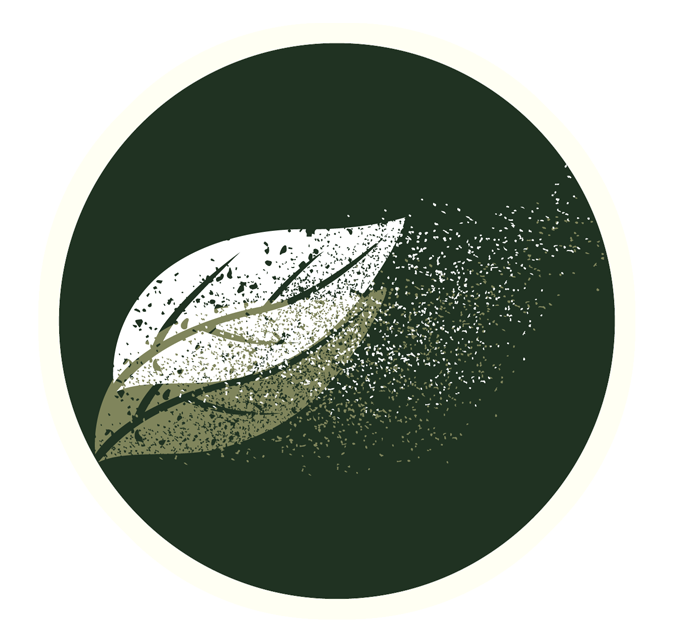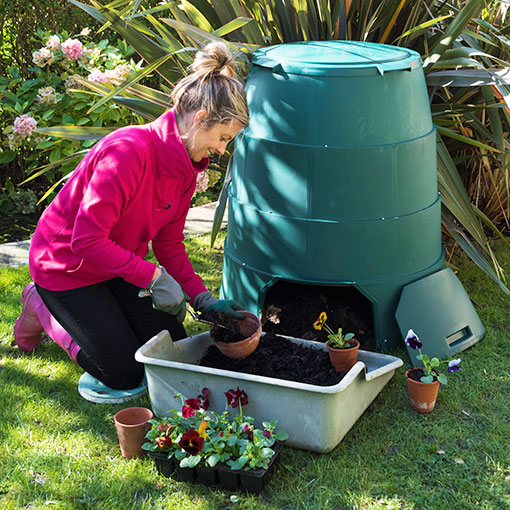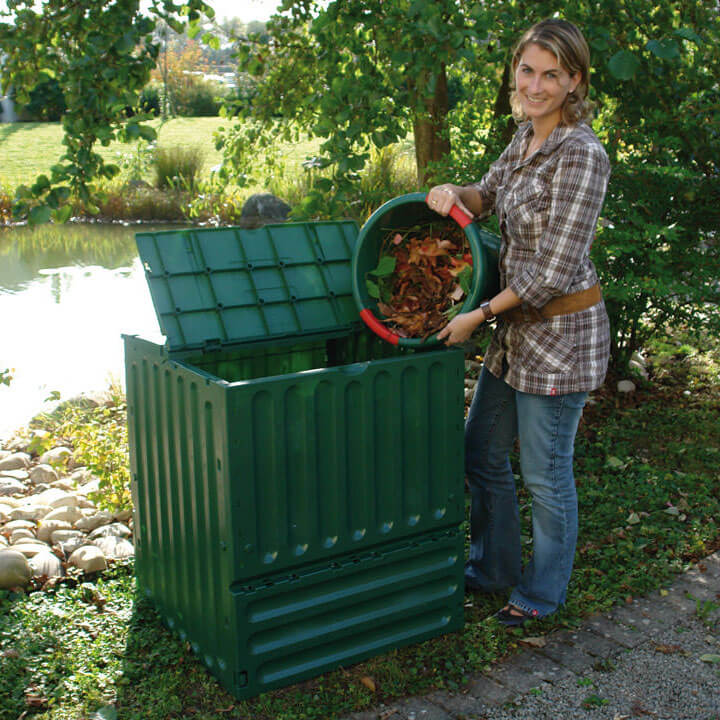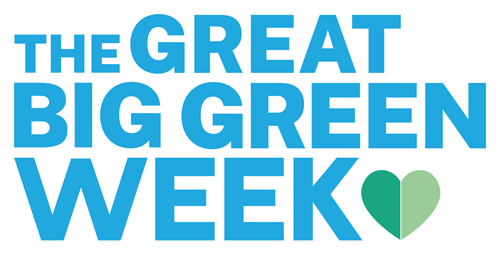Knowledge of the damage that food waste does to the environment has led to a sea change in most people’s behaviour over the past few years.
These changes are only going to gather momentum in the future as we get to grips with what we need to do, or stop doing, in our individual lives to tackle the climate crisis.
In addressing kitchen waste, the first change is obviously to minimise the amount of food waste we create because of the environmental cost involved in the production and transporting of food before we even buy it. This means planning meals in advance and using or freezing leftovers.
But when it comes to dealing with unavoidable food waste, composting is a no-brainer.
The Green Johanna is designed to help you establish fuss-free hot composting, even if you’re a beginner. The Johanna consistently performs well in comparison guides – in January 2022 it was a recommended Star Buy in Gardeners’ World magazine, commended on the grounds that it accepts all types of food and garden waste, doesn’t need pre-mixing, has a large capacity and is made from recycled plastic.
A Swedish success
The Johanna was designed and originally manufactured in Sweden, which was far ahead of other countries in spotting the need to change attitudes to waste management. Way back in 1995 Gothenburg University compiled a study on home composters, basing comparisons mainly on ventilation, oxygen supply, drainage and ease of handling. Of the 21 Swedish bins being studied the Johanna came out top. Also praised by the research team was the quality of information provided in the instruction booklet, and this is significant. When it comes to composting, a little knowledge goes a long way towards ensuring that people have good outcomes and so continue composting.
There are a few things you need to understand if you want to be a happy composter but once you know, you know. It’s not like you’re going to have to keep unlearning the old ways when some new-fangled thing comes along; the laws of nature aren’t going to change. You learn this stuff once.
Full instructions are included in the user manual, of course, but here are a few extra points to remember:
When siting your Johanna think about how easy it will be to get to, especially in winter in bad weather. For example, you wouldn’t want a slippy walk down an incline to reach it. Full disclosure – that was a rookie error made by one of our team, who shall remain nameless.
Choose a shady spot so the container doesn’t get too hot for the composting micro-organisms in the summer. If there is a rodent problem locally, try to choose a spot away from fence lines, logpiles and bushes.
Essential ingredients for composting include air, heat and moisture.
AIR – The micro-organisms that live and work in the compost need oxygen. Without it, the compost will smell bad and the process will be delayed or stop altogether. So, ensure you add waste materials loosely and stir well every month so that oxygen is always available.
HEAT – As the micro-organisms break down the waste, they generate heat. As the temperature in the compost fluctuates, the types of micro-organisms present also change. This diversity is important to achieve successful composting. The optimum working temperature in the composter will be around 45-65 degrees Celsius.
MOISTURE – Composting can’t begin in the absence of water, so it’s important to make sure that the waste materials in the composter contain some moisture. The compost should be as damp as a squeezed bath sponge. If you take a big handful of compost and squeeze it, only a couple of drops of liquid should come out. A balance in the amount of dry and wet materials added will create the right consistency. Adding two parts food waste to one part garden waste should be enough to ensure this, but if in doubt try the ‘squeeze test’ and add different materials as required.
Design features
As noted decades ago in the Gothenburg study, the Johanna’s design promotes the good ventilation and airflow necessary for happy hot composting.
Vents leading in from the base plate allow air to flow upwards into the container. The round shape ensures there are no cold corners so heat is spread evenly through the compost. The tapered design means that compost sinks towards the centre of the unit and not to its sides, allowing air to circulate and oxygenate the compost.
Lid ventilation system
The Johanna’s lid regulates the ventilation system by covering or uncovering the ventilation holes to adjust air circulation and temperature. It can be set to minimum in cold weather to maintain a warmer compost.
What does the Johanna digest?
The Johanna accepts cooked and uncooked food waste, including meat, fish, dairy, bread, fruit, citrus peel, vegetables, soup, cereals, pasta, rice, crushed eggshells, coffee grounds and filters, tea leaves, tea bags.
The only food-related materials that are not efficiently digested by the Johanna are those that require a very long time to break down, namely large amounts of cooking oil/fat and the hard shells of nuts and seafood, such as oysters and crabs.
PLEASE NOTE: While the Green Cone food waste digester will efficiently dispose of bones, it is possible that delaminated bones may be present in the Johanna’s finished compost. These are easily removed. However, if you have dogs and feel this would be a problem, we recommend that you do not add bones to the Green Johanna.
Food waste can be added directly or in compostable or biodegradable bags, never plastic. If you tie the bags, once you have added them to the Johanna break them open using the aerator stick to allow oxygen to reach the waste.
From the garden you can add: wilted flowers, grass clippings, leaves, twigs, branches, weeds, bark. Twigs and branches should be chopped or shredded to provide more surface area for micro-organisms to work on and so speed up the composting process.
How to aerate and layer your waste
Each time you add new waste, mix the top layer of compost using the aerator stick, which comes provided. This helps the micro-organisms to do their job properly and speeds up the composting process. About once a month, aerate the whole pile more thoroughly by moving the stick up and down in the compost to prevent it compacting.
It’s important to layer properly. Cover each addition of food waste with a layer of garden waste. Garden waste helps to maintain air gaps in the waste material. If you have the space, you could save summer and autumn garden waste for when you need it during the winter months.
Layering ensures a good mix of carbon and nitrogen, which speeds up the composting process.
Carbon-rich substances include woody garden waste, wood chips, sawdust, and paper products, such as cardboard and newspaper. Eggshells also provide carbon – crush them first. Your food waste provides nitrogen, as do fresh grass clippings and fresh green leaves.
Can I compost without garden waste?
If you lack garden waste, you can use the other sources of carbon mentioned. Cardboard or paper should be scrunched up, toilet roll tubes and egg cartons torn up and newspaper shredded. Wood chips are useful as they hold structure and create pathways for air.
In winter, in order to boost the breakdown process you can add bokashi bran (available separately), fermented waste from a Bokashi bin, or a bucketful of mature compost. A Winter Jacket is also available separately to provide insulation during cold months, but this must be removed in warmer weather or the temperature inside the unit will become too hot for the composting creatures to survive.
And finally…
To access your finished compost simply unscrew the hatches at the bottom of the Johanna and remove the compost using the aerator stick or a garden hoe. Alternatively, because the Johanna is a modular unit you can unscrew the upper sections to access larger amounts of compost.
If you are a newbie in the world of composting, please don’t hesitate to contact Great Green Systems for advice.




